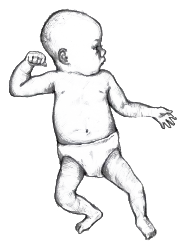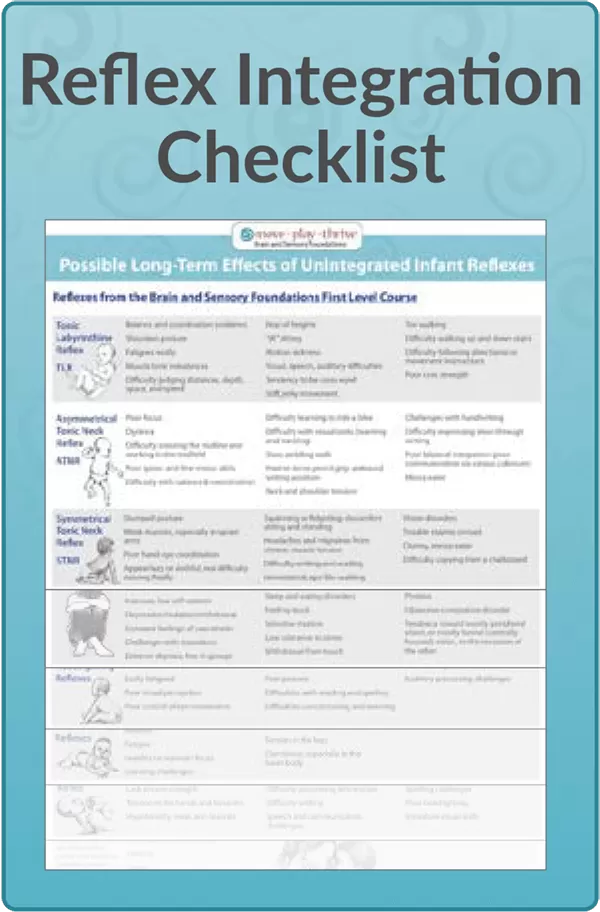Asymmetrical Tonic Neck Reflex
 The Asymmetrical Tonic Neck Reflex (ATNR) is important for helping with ADHD, sensory processing challenges, motor challenges, and learning issues. The ATNR links the head, eyes, and limbs together; resulting in automatic movement of the eyes and limbs when the infant turns the head to the side. In this asymmetrical response the arm and leg on the face side of the head extend, while the limbs on the opposite side flex and curl up towards the head. Emerging around 18 weeks in utero, ATNR initially gives the fetus stimulation for developing muscle tone and the vestibular system.
The Asymmetrical Tonic Neck Reflex (ATNR) is important for helping with ADHD, sensory processing challenges, motor challenges, and learning issues. The ATNR links the head, eyes, and limbs together; resulting in automatic movement of the eyes and limbs when the infant turns the head to the side. In this asymmetrical response the arm and leg on the face side of the head extend, while the limbs on the opposite side flex and curl up towards the head. Emerging around 18 weeks in utero, ATNR initially gives the fetus stimulation for developing muscle tone and the vestibular system.
The ATNR assists in the birth process, providing the means for the baby to “corkscrew” down the birth passage. Babies born via C-section consequently miss this portion of the ATNR cycle. After birth the ATNR trains the infant in hand-eye coordination, and develops: binocular vision, hearing with both ears, awareness of both sides of the body, and the ability to cross midline. By 6 months of age, this reflex should integrate and allow more complex movement patterns, such as belly crawling, to develop.
If the ATNR does not integrate, then the head, eyes, and limbs remain tied together; becoming a hinderance as the child ages. Independent movement of the eyes, head, and limbs may not be possible, or only possible through compensation and effort, causing underlying muscle tension. For example, adults with an unintegrated ATNR may tense up while driving in an effort to override the impulse of the arms to move when the head turns. Additionally, access to the midline of the body can be blocked, and the eyes may not team well together, impacting learning.
An unintegrated Asymmetrical Tonic Neck Reflex is one of the most significant causes of inability to function well in school. This reflex is nearly always retained in children with dyslexia. In a randomized, double-blind, controlled study, children with dyslexia greatly improved their ability to read after integrating the ATNR.
Possible Long-Term Effects of an Unintegrated Asymmetrical Tonic Neck Reflex include:
- ADHD
- Emotional and behavioral distrubances
- Visual teaming and tracking issues
- Dyslexia and spelling difficulties
- Difficulty with math
- Poor sense of direction
- Confused handedness, poor handwriting
- Difficulty crossing midline
- Poor focus
- Pelvic assymetry
- Balance and coordination deficits
- Neck and shoulder tension
- Auditory issues
- Opposition and defiance
- Amphibian Reflex
- Asymmetrical Tonic Neck Reflex
- Birth and Bonding
- Crawling Reflexes
- Crossed Extensor Reflex
- Facial-Oral Reflexes
- Fear Paralysis Reflex
- Feet Reflexes—Plantar & Babkinski
- Foot Tendon Guard
- Hand Reflexes—Grasp, Palmar, and Babkin
- Headrighting Reflexes
- Infant Torticollis
- Landau Reflex
- Moro Reflex
- Parachute Reflex
- Pull-to-Sit Reflex
- Spinal Galant Reflex
- Spinal Perez Reflex
- Symmetrical Tonic Neck Reflex
- Tonic Labyrinthine Reflex
Sources
Blomberg, H. (2015). The rhythmic movement method: A revolutionary approach to improved health and well-being. Lulu.com.
Bly, L. (2011). Components of typical and atypical motor development. Neuro-Developmental Treatment Association, Incorporated.
Domingo-Sanz, V. A. (2024). Persistence of primitive reflexes associated with asymmetries in fixation and ocular motility values. Journal of Eye Movement Research, 17(2).
Gieysztor, E., Pecuch, A., Kowal, M., Borowicz, W., & Paprocka-Borowicz, M. (2020). Pelvic symmetry is influenced by asymmetrical tonic neck reflex during young children’s gait. International Journal of Environmental Research and Public Health, 17(13), 4759.
Goddard Blythe, S. (2023). Reflexes, movement, learning & behavior. Analysing and unblocking neuro-motor immaturity. Hawthorn Press.
Goddard Blythe, S. (2014). Neuromotor immaturity in children and adults: The INPP screening test for clinicians and health practitioners. John Wiley & Sons.
Hickey, J., & Feldhacker, D. R. (2022). Primitive reflex retention and attention among preschool children. Journal of Occupational Therapy, Schools, & Early Intervention, 15(1), 1-13.
Jordan-Black, J. (2005). The effects of the Primary Movement programme on the academic performance of children attending ordinary primary school. Journal of Research in Special Educational Needs, 5(3), 101-111.
Konicarova, J., & Bob, P. (2013). Asymmetric tonic neck reflex and symptoms of attention deficit and hyperactivity disorder in children. International Journal of Neuroscience, 123(11), 766-769.
Masgutova, S. (2007). Integration of infant dynamic and postural reflex patterns: Neuro-sensory-motor and reflex integration method [Training manual].
Richards, L., Avery, R., Gray, S., & Price, R. (2022). Relationship of retained primitive reflexes and handwriting difficulty in elementary-age children. The American Journal of Occupational Therapy, 76 (Supplement_1), 7610505010p1.
Taylor, M., Chapman, E., & Houghton, S. (2004). Primitive reflexes and attention-deficit/hyperactivity disorder: Developmental origins of classroom dysfunction. International Journal of Special Education, 19(1), 23-37.
Taylor, B., Hanna, D., & McPhillips, M. (2020). Motor problems in children with severe emotional and behavioural difficulties. British Journal of Educational Psychology, 90(3), 719–735.
Wang, M., Yu, J., Kim, H. D., & Cruz, A. B. (2023). Attention deficit hyperactivity disorder is associated with (a) symmetric tonic neck primitive reflexes: a systematic review and meta-analysis. Frontiers in Psychiatry, 14, 1175974.


